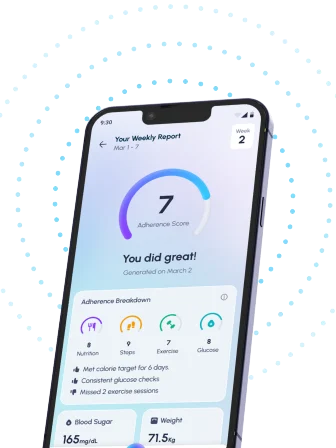Table of Contents
- Understanding Diabetes: Key Health Basics for Consumers
- What is Diabetes? A Simple Guide to Types and Symptoms
- Managing Your Diabetes: Essential Daily Habits and Tips
- Diabetes Diet Guide: Food Choices and Meal Planning Strategies
- Living Well with Diabetes: Resources and Support for You
- Frequently Asked Questions
- References
Living with diabetes, or supporting someone who does, can feel overwhelming. There’s so much information out there, it’s hard to know where to begin. That’s why we created this blog, Understanding Diabetes: A Consumer’s Guide to Key Health Basics. We’ll break down the essentials in a clear, concise way, helping you navigate the complexities of this condition. This guide is designed to empower you with the knowledge you need to make informed decisions about your health and well-being. Get ready to demystify diabetes and take control of your health journey!
Understanding Diabetes: Key Health Basics for Consumers
Diabetes affects a significant portion of the global population, with a substantial number falling within the 20-64 age group (61%, according to the International Diabetes Federation). In Indian and tropical countries, where lifestyle changes are rapidly occurring, understanding diabetes is crucial for maintaining good health. This guide provides key health basics for consumers in these regions.
Understanding Type 1 and Type 2 Diabetes
Diabetes is a metabolic disorder characterized by high blood sugar levels. Type 1 diabetes, often diagnosed in younger individuals, involves the body’s inability to produce insulin. Type 2 diabetes, more common, is characterized by insulin resistance, where the body doesn’t use insulin effectively. Managing blood sugar levels is vital in both types, and often requires lifestyle changes and/or medication.
Managing Diabetes in Hot Climates
In hot and humid climates prevalent in many Indian and tropical countries, managing diabetes requires extra attention. Dehydration can significantly impact blood sugar levels, so staying well-hydrated is paramount. Regular monitoring of blood glucose, especially during periods of intense heat, is crucial. Additionally, individuals with diabetes should be mindful of heatstroke, a serious health risk.
Practical Tips for Better Management
Adopting a healthy lifestyle is key. This includes incorporating regular physical activity into your routine, even small amounts of exercise can help. A balanced diet rich in fruits, vegetables, and whole grains, while limiting processed foods and sugary drinks, is essential. Consult a healthcare professional for personalized advice tailored to your specific needs and regional context. Regular checkups and proactive management are key to preventing or mitigating long-term complications. Remember, early detection and management can significantly improve your quality of life. For more in-depth advice on managing your diabetes as you age, see our article on Managing Diabetes as You Age: Challenges and Solutions. And for practical, actionable steps, check out our 10 Proven Tips for Effective Diabetes Management.
What is Diabetes? A Simple Guide to Types and Symptoms
Diabetes is a chronic condition affecting millions globally. The International Diabetes Federation projects a staggering increase in cases, from 536.6 million in 2021 to a projected 783.7 million by 2045. This alarming rise highlights the urgent need for understanding this disease, particularly in regions like India and other tropical countries where prevalence is significantly high.
Understanding the Types of Diabetes
There are primarily two main types of diabetes: type 1 and type 2. Type 1 diabetes is an autoimmune condition where the body’s immune system attacks the insulin-producing cells in the pancreas. This results in a complete lack of insulin, making it essential to manage with insulin injections. Type 2 diabetes, the more common type, occurs when the body doesn’t produce enough insulin or the cells don’t respond effectively to insulin (insulin resistance). This often develops gradually, and lifestyle factors like diet and lack of physical activity play a significant role. Gestational diabetes develops during pregnancy and usually resolves after childbirth, but increases the risk of developing type 2 diabetes later in life.
Recognizing the Symptoms
The symptoms of diabetes can vary, but common indicators include frequent urination, especially at night, excessive thirst, unexplained weight loss, increased hunger, blurred vision, slow-healing sores, and frequent infections. In India and other tropical climates, certain symptoms might be masked or misinterpreted due to the prevalent heat and humidity. It is crucial to consult a doctor if you experience any of these symptoms. Early diagnosis and management are essential for preventing serious long-term complications. The global rise in diabetes, with a projected increase from 9.8% prevalence in 2021 to 11.2% in 2045, underscores the importance of proactive health management and seeking medical attention promptly. Early detection can significantly improve quality of life and prevent serious health issues. For more information on early signs, you might find 10 Early Signs and Symptoms of Diabetes? – Tap Health helpful. Once diagnosed, learning effective management strategies is key, and you can explore tips in this guide: 10 Proven Tips to Effectively Manage Diabetes | Simple Guide.
Managing Your Diabetes: Essential Daily Habits and Tips
Taking Control of Your Blood Sugar
Living with diabetes, particularly in hot and humid climates common to India and other tropical countries, requires diligent management. Up to 80% of Type 2 diabetes cases can be delayed or prevented through lifestyle changes, a powerful statistic highlighting the importance of proactive daily habits. This means focusing on consistent blood sugar monitoring and adopting a tailored approach to diet and exercise. Remember, even small, consistent changes can make a significant difference in your overall health and well-being.
Dietary Strategies for Effective Blood Sugar Control
Prioritize a balanced diet rich in fresh fruits, vegetables, and whole grains. Focus on incorporating foods with a low glycemic index, which means they don’t cause rapid spikes in blood sugar. In Indian cuisine, this could mean emphasizing lentils (dal), leafy greens, and avoiding excessive refined carbohydrates like white rice and sugary sweets. Staying hydrated is also crucial, especially in warmer climates, so aim for plenty of water throughout the day. Regular meals and snacks can help prevent blood sugar fluctuations, avoiding prolonged periods of fasting.
Exercise and Physical Activity in Tropical Climates
Regular physical activity is paramount. Aim for at least 30 minutes of moderate-intensity exercise most days of the week. Consider activities suitable for the climate, perhaps early morning or evening walks or yoga. Remember to stay hydrated and avoid exercising during the hottest parts of the day. Finding an activity you enjoy will increase adherence and make managing your diabetes a more sustainable and less burdensome part of your daily routine. For more tips on avoiding common pitfalls, check out 5 Common Mistakes People Make in Managing Diabetes.
Seeking Support and Resources
Connecting with support groups and healthcare professionals is essential. Regular check-ups and open communication with your doctor will help you adjust your management plan as needed. Remember, you’re not alone in this journey. Taking control of your diabetes is a marathon, not a sprint; consistent effort leads to improved health and a better quality of life. Embrace these tips and consult local healthcare providers for personalized guidance. If you’re managing Type 1 diabetes, you might find 10 Daily Habits for Better Type 1 Diabetes Control particularly helpful.
Diabetes Diet Guide: Food Choices and Meal Planning Strategies
Managing diabetes effectively in Indian and tropical climates requires a nuanced approach to diet. Understanding carbohydrate intake is crucial. Generally, a balanced meal plan includes 45–60 grams of carbohydrates, but this can vary significantly based on individual needs, activity levels, and medication. Consulting a doctor or registered dietitian is essential to personalize your carbohydrate targets.
Choosing the Right Foods
Prioritize complex carbohydrates like whole grains (brown rice, millets like ragi and jowar, whole wheat roti), legumes (lentils, beans), and starchy vegetables (sweet potatoes, potatoes). These release sugar into the bloodstream more slowly than refined carbohydrates (white bread, white rice, sugary drinks). Incorporating plenty of fresh fruits and vegetables, rich in fiber and vitamins, is also vital. Consider seasonal fruits abundant in your region for optimal nutritional value. Examples include mangoes (in season), papaya, and various citrus fruits.
Meal Planning for Effective Blood Sugar Control
Effective meal planning involves distributing carbohydrate intake evenly throughout the day. Avoid large meals, especially those high in refined sugars, which can lead to rapid blood sugar spikes. Smaller, more frequent meals can help maintain stable blood sugar levels. Remember to include protein and healthy fats in every meal to promote satiety and slow down carbohydrate absorption. Think of incorporating spices commonly used in Indian cuisine like turmeric and cinnamon, known for their potential anti-inflammatory and blood sugar-regulating properties. For more specific guidance on portion sizes and meal timing, you might find our Diet Chart for Diabetic Patients to Control Diabetes helpful.
Regional Considerations
In tropical climates, staying hydrated is paramount. Watermelon and coconut water are excellent choices for hydration and electrolyte balance. Be mindful of the high sugar content in some tropical fruits and adjust portions accordingly to manage blood sugar effectively. Always consult with a healthcare professional or a registered dietitian familiar with dietary needs specific to your region to create a personalized diabetes management plan. If weight management is a goal alongside diabetes control, check out our guide on How to Lose Weight with Diabetes Diet Plan.
Living Well with Diabetes: Resources and Support for You
Managing diabetes effectively is crucial, especially considering that over 75% of people with diabetes live in low- and middle-income countries, as highlighted by the International Diabetes Federation. This statistic underscores the importance of accessible and culturally relevant support for individuals in India and other tropical countries. Effective diabetes management isn’t just about medication; it’s about lifestyle changes and community support.
Navigating Diabetes in Your Community
Many challenges exist for individuals with diabetes in resource-constrained settings. Access to affordable medication, regular check-ups, and diabetes education can be limited. Therefore, building a strong support network is key. This includes connecting with local diabetes support groups, seeking guidance from community health workers, and engaging with family and friends for encouragement and practical assistance.
Practical Steps for Better Management
Prioritize affordable, locally sourced foods in your diet. Focus on whole grains, fruits, and vegetables, which are often more readily available and cost-effective. Regular physical activity, even short walks, can significantly improve blood sugar control. Remember, small consistent changes make a big difference. Seek out free or low-cost resources available in your community. Many NGOs and government programs offer diabetes education and support. For parents of children with Type 1 diabetes, Tips for Parents of Kids with Type 1 Diabetes: Complete Guide offers valuable insights and support.
Finding Support Near You
Look for local clinics and hospitals that offer diabetes care services. Inquire about affordable medication options and educational programs. Don’t hesitate to seek help – you are not alone. Connecting with others facing similar challenges can create a powerful support system and empower you to live well with diabetes. Take the first step today and reach out to your local healthcare provider or community support network. Planning travel while managing diabetes? Check out Traveling with Diabetes: Essential Tips for a Safe & Healthy Journey for helpful advice.
Frequently Asked Questions
Q1. What is diabetes and how does it affect the body?
Diabetes is a metabolic disorder where your blood sugar levels are too high. There are two main types: Type 1, where your body doesn’t produce insulin, and Type 2, where your body doesn’t use insulin properly. High blood sugar can damage organs over time.
Q2. How can I manage my diabetes effectively?
Effective diabetes management involves lifestyle changes like regular exercise, a balanced diet (lots of fruits, vegetables, and whole grains), and maintaining a healthy weight. Depending on your type of diabetes, medication may also be necessary. Regular monitoring of your blood sugar is crucial.
Q3. What are the special considerations for managing diabetes in hot climates?
In hot climates, staying well-hydrated is extremely important because dehydration can affect your blood sugar levels. You should monitor your blood sugar more frequently in hot weather and be aware of the signs and symptoms of heatstroke.
Q4. What are the benefits of early detection and consistent management of diabetes?
Early detection and consistent management of diabetes are crucial for preventing long-term complications and significantly improving your quality of life. It helps reduce the risk of serious health problems associated with high blood sugar.
Q5. Where can I get personalized advice for managing my diabetes?
It’s essential to seek personalized advice from healthcare professionals like doctors or diabetes educators. They can create a management plan tailored to your specific needs and help you prevent long-term complications.
References
- A Practical Guide to Integrated Type 2 Diabetes Care: https://www.hse.ie/eng/services/list/2/primarycare/east-coast-diabetes-service/management-of-type-2-diabetes/diabetes-and-pregnancy/icgp-guide-to-integrated-type-2.pdf
- Your Guide to Diabetes: Type 1 and Type 2: https://www.niddk.nih.gov/-/media/Files/Diabetes/YourGuide2Diabetes_508.pdf




